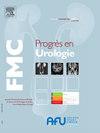Biopsies prostatiques par voie transpérinéale sous anesthésie locale
Q4 Medicine
引用次数: 0
Abstract
Les dernières années ont vu apparaître en France un regain d’intérêt pour la voie transpérinéale, mais la faisabilité du geste en consultation sous anesthésie locale reste discutée. L’objectif de cet article est de faire le point sur la technique et les conditions de réalisation des biopsies prostatiques transpérinéales sous anesthésie locale. Le seul matériel indispensable est une sonde d’échographie dédiée avec un capteur latéral, aussi appelée side-fire. L’utilisation d’un guide n’est pas indispensable, mais permet de gagner du temps, de réduire le nombre de tentatives de ponction, et facilite la courbe d’apprentissage. L’anesthésie locale est réalisée en 2 temps : une anesthésie superficielle, et un bloc périprostatique avec infiltration du plan postérieur facilitant également les biopsies postérieures de la zone périphérique. Des biopsies systématisées peuvent être associées aux biopsies ciblées avec proposition d’un schéma à 12 biopsies. Une vidéo permet de reprendre les différents temps du geste, qui est un peu plus long qu’une procédure transrectale, et avec un niveau de douleur un peu plus élevé, inconvénients contrebalancés par la simplicité de réalisation du geste, l’économie antibiotique et la très probable réduction du risque infectieux en vie réelle.
The past years have witnessed a renewed interest for the transperineal route in France, although the feasibility of the procedure under local anesthesia remains challenged. The objective of this article is to focus on the setting and technique for the performance of transperineal prostate biopsies under local anesthesia. The only mandatory equipment is a dedicated ultrasound probe with a laterally-located sensor, also called side-fire. The use of a biopsy guide is not mandatory, but it helps to save time, reduces the number of puncture attempts, and eases the learning curve. Local anesthesia is administered in 2 steps: a superficial anesthesia, and a periprostatic block with infiltration of the posterior plane, which facilitates the performance of posterior, peripheral zone biopsies. Systematic biopsies can be added to targeted biopsies, and a 12-core biopsy template is presented. A video details all the steps of the procedure, which remains longer than a transrectal procedure, and slightly more painful, but these drawbacks are balanced by the straightforwardness of the gesture, antibiotic stewardship and likely reduction of the infection risk in real-life.
局部麻醉下的经皮层前列腺活检
在过去的几年里,法国对经颅通路的兴趣重新燃起,但在局部麻醉下进行会诊的可行性仍在讨论中。本文的目的是概述在局部麻醉下进行经肾上腺前列腺活检的技术和条件。唯一需要的设备是带有侧火传感器的专用超声波探头。使用指南不是必需的,但它节省了时间,减少了穿刺的次数,并使学习曲线更容易。局部麻醉分为两个阶段:一个是浅表麻醉,另一个是带有后平面浸润的前列腺阻塞,这也有助于对周围区域进行后续活检。系统活检可与目标活检相结合,建议采用12例活检方案。一段视频可以恢复时间不同的姿态,是稍长,经直肠程序,并与疼痛程度稍高,缺点所抵消,实现简单的手势、抗生素及经济很可能减少感染风险的真实生活。在过去的几年里,在法国,人们对围产期通路重新产生了兴趣,尽管在局部麻醉下进行手术的可能性仍然存在挑战。本文的目的是探讨在局部麻醉下进行围产期前列腺活检的设置和技术。唯一的强制性设备是带有横向定位传感器的专用超声波探头,也称为侧火。活检指南的使用不是强制性的,但它有助于节省时间,减少穿刺尝试的次数,并简化学习曲线。局部麻醉分2个阶段进行:浅表麻醉和带后平面浸润的前列腺周围阻滞,以促进后周区域活检的执行。系统活检可以添加到有针对性的活检中,并提出了一个12核活检模板。这段视频详细介绍了手术的所有步骤,比直肠手术要长,也比直肠手术更痛苦,但这些步骤被手术的直接性、抗生素护理和现实生活中感染风险的可能降低所平衡。
本文章由计算机程序翻译,如有差异,请以英文原文为准。
求助全文
约1分钟内获得全文
求助全文

 求助内容:
求助内容: 应助结果提醒方式:
应助结果提醒方式:


